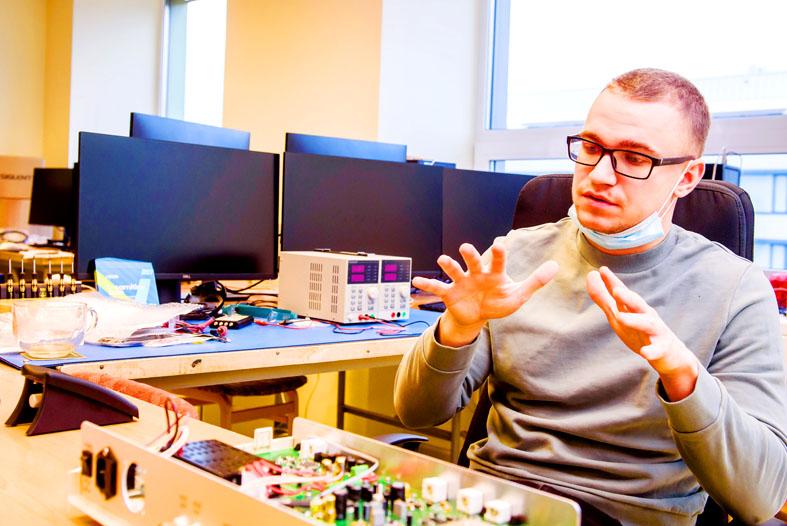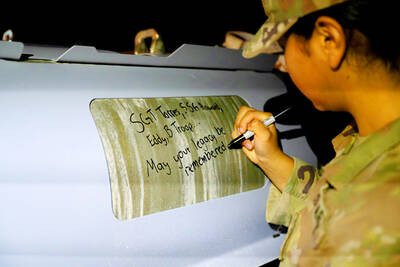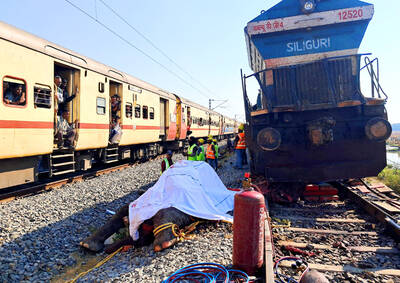In a corner of the campus at Riga Technical University, a team of scientists is working on technology that could one day stop asteroids from smashing into Earth.
The high-precision timers being built by hand in the laboratory of Latvian start-up Eventech are currently being used to track satellites.
The company earlier this year won a European Space Agency (ESA) contract to develop timers that would study the possibility of redirecting an asteroid before it comes too close to our planet for comfort.

Photo: AFP
NASA plans to launch the first part of the Asteroid Impact and Deflection Assessment mission — known as the Double Asteroid Redirection Test — on July 22 next year on a Space X Falcon 9 rocket.
The 500kg camera-equipped probe is to fly to an asteroid named Didymos and smash into it, trying to blow it off its current course that will see it pass near Earth sometime in 2123.
Eventech’s deep space event timers are being developed for the follow-up HERA mission, which is planned to launch five years later, to determine if the first mission succeeded.
“Our new technology that will follow on the second ESA spacecraft named HERA will measure if the first impact steered the kilometer-sized Didymos off its previous course, avoiding harm to humanity,” Eventech engineer Imants Pulkstenis said.
“It’s much more interesting to boldly go where no man has gone before than to manufacture some mundane consumer electronics for huge profit,” he added, borrowing the famous slogan from Star Trek, the 1960s science fiction TV series.
Eventech’s timers are part of a space technology tradition in the Baltic state stretching back to Soviet times when Sputnik — the first manufactured satellite to orbit the Earth — was launched in 1957.
They measure the time needed for an impulse of light to travel to an object in orbit and back.
Eventech devices can record the measurement to within a picosecond — or one-trillionth of a second — which allows astronomers to convert a time measure into a distance measurement with up to 2mm of precision.
About 10 of the timers are produced every year and they are used in observatories around the world.
They track Earth’s increasingly crowded atmosphere, filled with a new crop of private satellites alongside traditional scientific and military ones.
“Tracking them all requires tools,” Eventech chief operations officer Pavels Razmajevs said.
Eventech’s engineers said that they use analogue parts as much as possible, mainly because microchips take nanoseconds to compute the signal, which is too long for incoming measurements ranging in picoseconds.
While these timers are used for calculations on Earth, a different appliance for space missions is being developed in another corner of the same laboratory to track planetary objects from a moving space probe.
“There is no GPS data coverage available on other planets, so you have to take your own precision ranging with you,” Pulkstenis said.
Developing devices for space would be a complex task, but one Eventech’s engineers are relishing.
“Our updated technology has to withstand extreme temperatures in space and extreme cosmic radiation,” Pulkstenis said. “It’s a fun challenge.”

REVENGE: Trump said he had the support of the Syrian government for the strikes, which took place in response to an Islamic State attack on US soldiers last week The US launched large-scale airstrikes on more than 70 targets across Syria, the Pentagon said on Friday, fulfilling US President Donald Trump’s vow to strike back after the killing of two US soldiers. “This is not the beginning of a war — it is a declaration of vengeance,” US Secretary of Defense Pete Hegseth wrote on social media. “Today, we hunted and we killed our enemies. Lots of them. And we will continue.” The US Central Command said that fighter jets, attack helicopters and artillery targeted ISIS infrastructure and weapon sites. “All terrorists who are evil enough to attack Americans are hereby warned

‘POLITICAL LOYALTY’: The move breaks with decades of precedent among US administrations, which have tended to leave career ambassadors in their posts US President Donald Trump’s administration has ordered dozens of US ambassadors to step down, people familiar with the matter said, a precedent-breaking recall that would leave embassies abroad without US Senate-confirmed leadership. The envoys, career diplomats who were almost all named to their jobs under former US president Joe Biden, were told over the phone in the past few days they needed to depart in the next few weeks, the people said. They would not be fired, but finding new roles would be a challenge given that many are far along in their careers and opportunities for senior diplomats can

Seven wild Asiatic elephants were killed and a calf was injured when a high-speed passenger train collided with a herd crossing the tracks in India’s northeastern state of Assam early yesterday, local authorities said. The train driver spotted the herd of about 100 elephants and used the emergency brakes, but the train still hit some of the animals, Indian Railways spokesman Kapinjal Kishore Sharma told reporters. Five train coaches and the engine derailed following the impact, but there were no human casualties, Sharma said. Veterinarians carried out autopsies on the dead elephants, which were to be buried later in the day. The accident site

RUSHED: The US pushed for the October deal to be ready for a ceremony with Trump, but sometimes it takes time to create an agreement that can hold, a Thai official said Defense officials from Thailand and Cambodia are to meet tomorrow to discuss the possibility of resuming a ceasefire between the two countries, Thailand’s top diplomat said yesterday, as border fighting entered a third week. A ceasefire agreement in October was rushed to ensure it could be witnessed by US President Donald Trump and lacked sufficient details to ensure the deal to end the armed conflict would hold, Thai Minister of Foreign Affairs Sihasak Phuangketkeow said after an ASEAN foreign ministers’ meeting in Kuala Lumpur. The two countries agreed to hold talks using their General Border Committee, an established bilateral mechanism, with Thailand